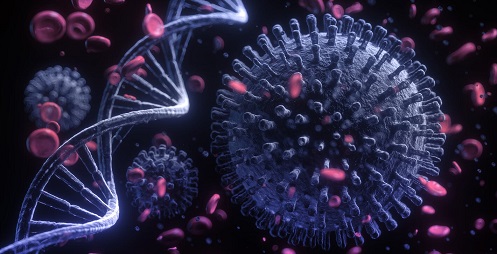University of Pennsylvania Study Finds That SARS-CoV-2 Uses Histone Mimicry To Disrupt Host Epigenetic Regulation For Disarming Host Immune Responses.
Source: Medical News -SARS-CoV-2 Research Oct 08, 2022 2 years, 6 months, 1 week, 3 days, 4 hours, 28 minutes ago
A new study led by researchers from the University of Pennsylvania, Philadelphia-USA has found that the SARS-CoV-2 coronavirus utilizes histone mimicry to disrupt host epigenetic regulation in order to disarm host immune responses.

The study findings showed that the SARS-CoV-2 protein encoded by ORF8 (ORF8) functions as a histone mimic of the ARKS motifs in histone H3 to disrupt host cell epigenetic regulation.
The open reading frame 8 (ORF8) is associated with chromatin, disrupts regulation of critical histone post-translational modifications and promotes chromatin compaction. Deletion of either the ORF8 gene or the histone mimic site attenuates the ability of SARS-CoV-2 to disrupt host cell chromatin, affects the transcriptional response to infection and attenuates viral genome copy number.
The study findings demonstrate a new function of ORF8 and a mechanism through which SARS-CoV-2 disrupts host cell epigenetic regulation.
The study findings also provide a molecular basis for the finding that SARS-CoV-2 variants lacking ORF8 or highly mutated versions of the ORF8 are associated with decreased severity of COVID-19.
The study also involved scientist from the University of Texas Medical Branch, Galveston-USA and Boston University and Boston Medical Center-USA.
The study findings were published in the peer reviewed journal: Nature.
https://www.nature.com/articles/s41586-022-05282-z
The SARS-CoV-2 coronavirus emerged at the end of 2019 and caused the devastating global pandemic of coronavirus disease 2019 (COVID-19), in part because of its ability to effectively suppress host cell responses.
It has been found that in certain viral infections, viral proteins dampen antiviral responses by mimicking critical regions of human histone proteins, particularly those containing post-translational modifications required for transcriptional regulation.
https://pubmed.ncbi.nlm.nih.gov/22419161/
https://pubmed.ncbi.nlm.nih.gov/24733380/
https://pubmed.ncbi.nlm.nih.gov/27362237/
https://pubmed.ncbi.nlm.nih.gov/28794020/
https://pubmed.ncbi.nlm.nih.gov/29934321/
https://pubmed.ncbi.nlm.nih.gov/10638745/
https://pubmed.ncbi.nlm.nih.gov/11498575/
https://pubmed.ncbi.nlm.nih.gov/17522673/
Past studies have also demonstrated that the SARS-CoV-2 virus markedly disrupts host cell epigenetic regulation.
https://pubmed.ncbi.nlm.nih.gov/33836156/
;
https://pubmed.ncbi.nlm.nih.gov/34517409/
https://pubmed.ncbi.nlm.nih.gov/35180380/
It was not clear however as to how SARS-CoV-2 controls the host cell epigenome and whether it uses histone mimicry to do so remain unclear.
Corresponding author Dr Erica Korb from the Department of Genetics at the Perelman School of Medicine at the University of Pennsylvania told Thailand
Medical News,"The study findings are the first that shows the SARS-CoV-2 protein encoded by ORF8 (ORF8) functions as a histone mimic of the ARKS motifs in histone H3 to disrupt host cell epigenetic regulation."
It should also be noted that the SARS-CoV-2 ORF8 proteins are already known to be associated with disarming host immune responses.
https://www.pnas.org/doi/10.1073/pnas.2021785118
https://journals.asm.org/doi/10.1128/mbio.00402-22
The study team have found evidence that suggests that one of the accessory proteins produced by the SARS-CoV-2 virus (ORF8) is able to mimic at least one type of histone protein (KAT2A) that packages DNA. And by doing so dampens the type of signaling that is supposed to occur when a host is infected, reducing the immune response.
The study findings also point towards a model in which ORF8 has multiple functions, including acting as a histone mimic motif.
Interestingly, the effects of deletion of accessory proteins from SARS-CoV-2 in a transgenic mouse model appear complex, with ORF8 loss causing decreases in replication and viral load but having limited effects on survival.
https://pubmed.ncbi.nlm.nih.gov/34133899/
Importantly, data from patients with COVID-19 were used to examine a rare 382-nucleotide deletion variation in SARS-CoV-2 isolated in Singapore that results in the loss of a small portion of ORF7B and the majority of the ORF8 gene. This work found that this SARS-CoV-2 variant is associated with a milder infection in patients with COVID-19 and an improved interferon response.
https://pubmed.ncbi.nlm.nih.gov/32822564/
https://link.springer.com/article/10.1007/s10875-021-01142-z
Furthermore, the study team’s findings in human iAT2 pulmonary cells point towards the loss of ORF8 as a possible cause for these differences and provide an epigenetic mechanism underlying the role of ORF8 in promoting SARS-CoV-2 virulence within the patient population.
The study findings have critical implications for understanding emerging viral strains carrying deletions and mutations in the ORF8 gene and COVID-19 pathogenesis in patients.
https://pubmed.ncbi.nlm.nih.gov/35301412/
For the latest
SARS-CoV-2 Research, keep on logging to Thailand
Medical News.
